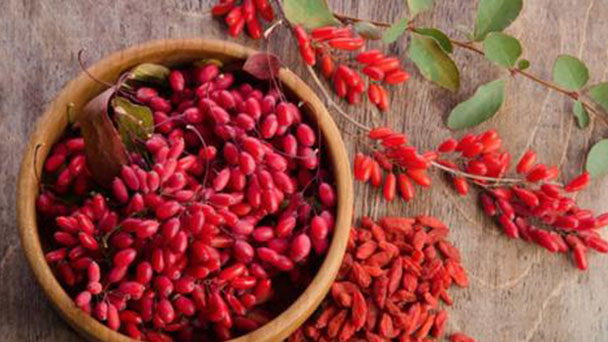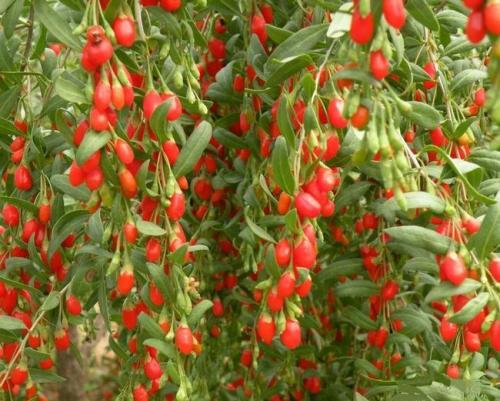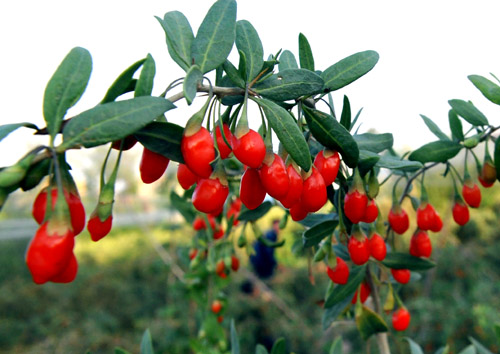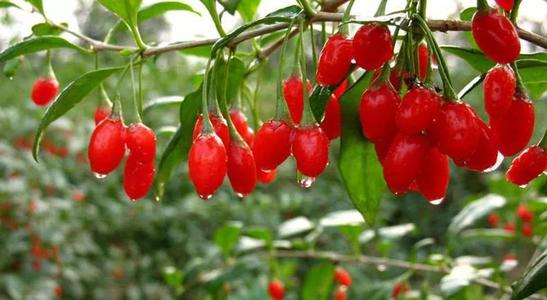Lycium chinense profile
Written by Maggie
Jan 29 2021

Lycium Chinense fruits are harvested in summer and autumn. Remove the stalks, put them in a cool place to dry until the skin becomes wrinkled, and then expose them to the sun until the skin is dry and hard and the flesh is soft. In case of overcast rain, Lycium Chinense can be dried by a small fire.
Lycium chinense picture

Morphological characteristics of Lycium chinense
Branch
Lycium chinense is a deciduous shrub with short plants and about 1 m tall. Branches are slender, apex often curved, stem cluster has short thorns.
Leaf
Leaves of lycium chinense are ovate-lanceolate, alternate or several clumps of Lycium chinense; Summer and autumn open lilac flowers, one or two clusters; Ovoid is red berries; Flat is kidney-shaped seeds. Vine, thin stem, gray skin, with short spines, in leaf axils, about 0.5-2 cm long. Leaf-blade of Lycium Chinense is slightly smaller, ovate, ovate-whip, oblong-elliptic or ovate-lanceolate, 2-6 cm long, 0.5-2.5 cm wide, apex acute or obtuse, base narrowly cuneate, entire, glabrous on both surfaces.
Flowers
Flowers of Lycium Chinense are purple, margin densely ciliate in Lycium chinense; Calyx is campanulate, 3-5-lobed; Corolla tube is as long as lobes, tube sharply contracting below, then expanding upward into funnelform, tube and lobes are wide; Lycium Chinense has 5 stamens, inserted into corolla, slightly shorter than corolla, flowers T-shaped, filaments usually protruding. Berries are ovate or oblong, 10-15 mm long, 4-8 mm in diameter, yellow seeds.
Ecological habits of Lycium chinense
Lycium chinense likes light, slightly shade tolerance, dry and cool climate, cold resistance, strong adaptability, drought and alkali resistance, loose, well-drained sandy loam, avoid clay and low humidity environment. The soil requirements of Lycium Chinense are not strict, salt and alkali resistance, fertilizer resistance, drought resistance, afraid of water stains. It is advisable to cultivate fertile and well-drained neutral or slightly acidic light loam soil, and the salt content of saline-alkali soil should not exceed 0.2%. It is not suitable to cultivate in strongly alkaline, viscous loam soil, paddy field, swamp area.
Lycium Chinense main producing areas
Lycium Chinense is original in the north of China: north of Hebei, Inner Mongolia, north of Shanxi, north of Shaanxi, Gansu, Ningxia, Qinghai, Xinjiang have wild, as a result of fruit medicine and cultivation, China's central and southern many provinces have been introduced cultivation, especially Ningxia and Tianjin area cultivation, high yield. Modern Europe and Mediterranean coastal countries are widely cultivated and become wild.

The flower language of Lycium Chinense
Lycium Chinense: Prolong life, happy auspicious.
The main value of Lycium Chinense
Medicinal value
Lycium Chinense has an effect on immune function.
The value of forestry
Because of Lycium Chinense resistance to drought, it can grow on sandy land, so it can be used as a shrub for soil and water conservation, and because of its resistance to salt and alkali, it has become a pioneer in saline-alkali land.
Ornamental value
Lycium Chinense is a very good bonsai ornamental plant with a graceful tree shapes, emerald green leaves, light purple flowers and bright red fruits. Now, some Lycium Chinense has been cultivated for ornamental use. However, due to its resistance to cold, drought and waterlogging, it is difficult to plant Lycium Chinense in the rainy and waterlogged areas in the south of the Yangtze River.
Edible value
The young leaves can be used as vegetables. Lycium Chinense has become very popular in Guangdong, Guangxi and other places, and can be bought in vegetable markets. However, Lycium Chinense is basically Chinese in the south, without Ningxia Lycium Chinense. In Ningxia and other northwest regions, the use of Lycium chinense leaves as vegetables is less.
Lycium Chinense has listed as a "medicine and food dual-use" variety by the Ministry of Health. Lycium Chinense can be processed into a variety of food, beverage, health wine, health products and so on. Lycium Chinense is often added to soups and congee cooking.
Seed oil can be made into lubricating oil or cooking oil, and processed into health products, Lycium Chinense oil.

Latest Updated
- Benefits of Bugleweed - 7 Science-backed Health Benefits
- Bugleweed Dangers & Side Effects - Is It Poisonous?
- How to Plant Evergreen Trees - What You Should Know
- When to Plant Evergreens - Grow Guide for Evergreen Trees
- 12 Wonderful Evergreen Shrubs for Your Garden
- 12 Popular Evergreen Plants with Pictures for Beginners
- When And How To Prune A Lilac Bush Like a Pro
- How to Grow & Care for Lilac Vine (Hardenbergia Violacea)
- Japanese Lilac Tree (Syringa Reticulata) Care & Propagation Guide
- Shumard Oak Pros and Cons - What to Know
Popular Articles
- Winter maintenance of Antirrhinum Majus
- How to Grow Terminalia Mantaly Tree
- How to Grow and Care for Crossostephium Chinense
- How to grow Antirrhinum Majus in spring
- Peristeria Elata (Dove Orchid) Profile: Info & Care Guide
- Underwatered Snake Plant (Sansevieria Trifasciata) - Signs And How To Fix
- How to Care for Brazilian Jasmine Plant (Mandevilla Sanderi)
- How to Grow & Care for Graptopetalum Purple Delight in Summer
- Rosa Chinensis (China Rose): Plant Growing & Care Tips
- How to Care for Baby Sun Rose (Aptenia Cordifolia)